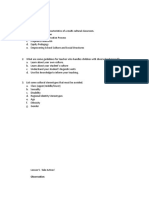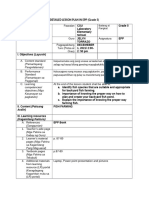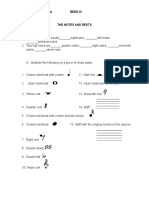TH TH RD ND ST
TH TH RD ND ST
Uploaded by
Kristine Joyce NodaloCopyright:
Available Formats
TH TH RD ND ST
TH TH RD ND ST
Uploaded by
Kristine Joyce NodaloOriginal Description:
Original Title
Copyright
Available Formats
Share this document
Did you find this document useful?
Is this content inappropriate?
Copyright:
Available Formats
TH TH RD ND ST
TH TH RD ND ST
Uploaded by
Kristine Joyce NodaloCopyright:
Available Formats
KRISTINE JOYCE M.
NODALO BEED-III
PRACTICE EXERCISES:
A. Questions to Answer :
1. What is a staff?
-A staff is composed of 5 horizontal, parallel lines spaced in 4 equal spaces. It is where
tones can be represented by notes.
2. What are the singing names on the lines?
-mi, sol, ti, re, fa
3. What are the singing names on the spaces?
-fa, la, do, mi
4. What are the pitch names of the lines?
-E, G, B , D, F
5. What are the pitch names of the spaces?
-F, A, C, E
6. What is the best way to remember the pitch names of the lines?
- Every Good Boy Does Fine
The pitch names of the spaces?
-FACE
Something to Do:
1. Draw on a clean piece of paper the staff below, then place and identify the singing
names on the right side of the lines and Spaces.
5th line fa
4th line re
3rd line ti
2nd line sol
1st line mi
2. Draw the Staff and place the pitch names on the right side of the lines and spaces.
5th line F 4th space E
4th line D 3rd space C
3RD line B 2nd space A
2nd line G 1st space F
1st line E
3. Illustrate the following musical names.
a. G Clef
b. F Clef
c. G Staff
d. F Staff
PRACTICAL EXERCISES:
A. Complete the following with the correct words:
1. A succession of tones arranged in a regular order ascending or descending is
called Scale.
2. A Pitch is the highness or lowness of a musical sound.
3. A Tone is a musical sound.
4-5. The two kinds of scales according to the interval are Dianotic Scale and
Chromatic Scale
B. Identify:
1. Half steps or semitones.
-Smallest Interval in music.
2. Raises the pitch of the note a half step.
-Sharp
3.Lowers the pitch of the note a half step.
-Flat
4. Note written between two notes.
-Intermediate Note
5. What are the 5 intermediate notes ascending?
-Di, Ri, Fi, Si (sel), Li
6. Cancels the effect of the sharp or the flat.
- The Natural Sign or Cancel
C. Answer the following briefly:
1. How are the tones below the tonic indicated in the scale name above the
tonic?
-The tones below the tonic or the tone above are indicated by a short line below
the scale name.
2. What are the short lines above or below the staff?
-Ledger lines.
3. Why are they necessary?
-The purpose of these lines is to extend the staff in both directions up and down.
You might also like
- Creating Instructional Materials Learning TaskDocument10 pagesCreating Instructional Materials Learning TaskKristine Joyce Nodalo100% (2)
- Sofa SyllablesDocument9 pagesSofa SyllablesIng rid0% (1)
- Novice and Expert LearningDocument14 pagesNovice and Expert LearningAlexa Kint ObaobNo ratings yet
- Eubie Blake Charleston Rag PDFDocument2 pagesEubie Blake Charleston Rag PDFGarland0% (1)
- MAPE JH The Staff Lesson 1 2Document18 pagesMAPE JH The Staff Lesson 1 2C SNo ratings yet
- ED 319 Lesson 1Document22 pagesED 319 Lesson 1Flordelez MacionNo ratings yet
- Activity Sheet in P.E.HDocument7 pagesActivity Sheet in P.E.HLea RufinoNo ratings yet
- Identify The Different Shapes You See in This Detail of A Page From A Thirteenth-Century BookDocument4 pagesIdentify The Different Shapes You See in This Detail of A Page From A Thirteenth-Century BookAaron Asne100% (1)
- LESSON 3 TechnologyDocument4 pagesLESSON 3 TechnologyMaureen Mae EstanolNo ratings yet
- Timeline On Historical Development On Children'S Literature and AdolescentDocument2 pagesTimeline On Historical Development On Children'S Literature and AdolescentJonna Jomadiao100% (1)
- Film Analysis Cum Reflection of The Films "Mga Munting Tinig" and "Dead Poet Society"Document8 pagesFilm Analysis Cum Reflection of The Films "Mga Munting Tinig" and "Dead Poet Society"Meynard LeonipaNo ratings yet
- FLCT Lesson Module 2Document25 pagesFLCT Lesson Module 2Cherry DerramasNo ratings yet
- Activity 6 in STSDocument2 pagesActivity 6 in STSmonica bravo miloNo ratings yet
- MTB Mle ReportDocument31 pagesMTB Mle ReportRandom BotNo ratings yet
- Madonna On The MeadowsDocument2 pagesMadonna On The Meadowsscrumptious03No ratings yet
- Kent Marianito-WPS OfficeDocument12 pagesKent Marianito-WPS OfficeKent Andojar MarianitoNo ratings yet
- Introduction of Mathematics Competencies in Grade IIDocument33 pagesIntroduction of Mathematics Competencies in Grade IIBen BandojoNo ratings yet
- Lesson 3Document6 pagesLesson 3Jayson Vargas100% (1)
- Basketball A Brief HistoryDocument13 pagesBasketball A Brief HistoryKyle Gabriel DonesNo ratings yet
- Teaching Social Studies in Elementary Grade: Group 5 Reporting in EED 110Document11 pagesTeaching Social Studies in Elementary Grade: Group 5 Reporting in EED 110Mae joyNo ratings yet
- Lesson 11 MusicDocument6 pagesLesson 11 MusicKim ArdaisNo ratings yet
- Lesson 14Document3 pagesLesson 14Nicky Ann Shegella CabornayNo ratings yet
- Traditional and ProgressiveDocument7 pagesTraditional and ProgressiveRinielNo ratings yet
- Disciplinary Foundation of Music EducationDocument10 pagesDisciplinary Foundation of Music EducationChanie Lynn MahinayNo ratings yet
- Do's and Don'tsDocument1 pageDo's and Don'tsAnjeanette Baltazar CayoteNo ratings yet
- Prof - Ed 109 Chapter1 (Millano, Jocelyn, O. Bse II Science)Document4 pagesProf - Ed 109 Chapter1 (Millano, Jocelyn, O. Bse II Science)Celyn MillanoNo ratings yet
- Human Environmental Factors Affecting MotivationDocument7 pagesHuman Environmental Factors Affecting MotivationginabonieveNo ratings yet
- The Music Teacher: AS19 MUSIC - Teaching Music in The Elementary Grades (Mmahelar/files)Document4 pagesThe Music Teacher: AS19 MUSIC - Teaching Music in The Elementary Grades (Mmahelar/files)MARIA MICHELLE A. HELAR100% (1)
- Elli's Ten Principles - Fermilan, Arra A.Document10 pagesElli's Ten Principles - Fermilan, Arra A.Arra FermilanNo ratings yet
- Part 14 - Grade 1 Edumate Music LP - Timbre of Orchestral InstrumentsDocument2 pagesPart 14 - Grade 1 Edumate Music LP - Timbre of Orchestral InstrumentsAndrewOribianaNo ratings yet
- CHAPTER 3: Social, Legal, and Ethical Implications of TestsDocument39 pagesCHAPTER 3: Social, Legal, and Ethical Implications of TestsBenjr Junjun NecesarioNo ratings yet
- Chapter 1 The Teaching ProfessionDocument4 pagesChapter 1 The Teaching ProfessionJely Taburnal BermundoNo ratings yet
- Cassanova Cubes 2Document5 pagesCassanova Cubes 2Karen Jamito MadridejosNo ratings yet
- Values of Art EducationDocument23 pagesValues of Art Educationkayezee.albaytarNo ratings yet
- Lawas, Caryl Marion Unit 2 Instructional Planning EssayDocument3 pagesLawas, Caryl Marion Unit 2 Instructional Planning Essaycaryl lawas100% (1)
- Chapter 1 Key Standards of EppDocument51 pagesChapter 1 Key Standards of EppAngelica SnchzNo ratings yet
- Activity 19 20Document2 pagesActivity 19 20SJC ITRNo ratings yet
- LESSON PLAN EppDocument13 pagesLESSON PLAN EppRodel Ortiz Gasmen0% (1)
- Name: Marisol T. Otida Course&Section: BeedDocument6 pagesName: Marisol T. Otida Course&Section: BeedMarisol OtidaNo ratings yet
- Math 4 Quarter 3Document5 pagesMath 4 Quarter 3MARICAR LALUSINNo ratings yet
- Module Number 6 Instructional Planning ModelsDocument7 pagesModule Number 6 Instructional Planning ModelsKZR BautistaNo ratings yet
- CG Science 5 (December 2013)Document23 pagesCG Science 5 (December 2013)jpanayNo ratings yet
- Butuan City: Saint Joseph Institute of TechnologyDocument7 pagesButuan City: Saint Joseph Institute of TechnologyNash Aguas IdolNo ratings yet
- Fraction Beed2a Elem5Document27 pagesFraction Beed2a Elem5Christine CamaraNo ratings yet
- MC-MATH-1: Daraga Community CollegeDocument4 pagesMC-MATH-1: Daraga Community CollegeAlissa Mariz LlorcaNo ratings yet
- FINAL MELC Mathematics6Document23 pagesFINAL MELC Mathematics6Kyzer Calix Laguit100% (1)
- Elementary Social Studies CurriculumDocument46 pagesElementary Social Studies CurriculumandreapalecpecNo ratings yet
- Module 13: Bruner's Constructivist TheoryDocument1 pageModule 13: Bruner's Constructivist TheoryDodong Tomada100% (1)
- Activity 1 Mathematics Curriculum in The Intermediate GradesDocument2 pagesActivity 1 Mathematics Curriculum in The Intermediate GradesRiza ReambonanzaNo ratings yet
- GMRC - ReviewerDocument3 pagesGMRC - ReviewerCharley Mhae IslaNo ratings yet
- Familiarize With The Country's Songs/music and Its ComposerDocument5 pagesFamiliarize With The Country's Songs/music and Its ComposerDenmark GenerosoNo ratings yet
- Epp Presentation Group 2Document15 pagesEpp Presentation Group 2Kharen PadlanNo ratings yet
- Name: Claivan Jade Rejuso Jabajab Year/Section/Course: 2 - A BEEDDocument2 pagesName: Claivan Jade Rejuso Jabajab Year/Section/Course: 2 - A BEEDJabajab Klayban jaydNo ratings yet
- Unit 7: Strategies For Teaching Geographic Concepts and SkillsDocument14 pagesUnit 7: Strategies For Teaching Geographic Concepts and SkillsRachel Anne TapangNo ratings yet
- Participation Rubric For F2F (ENG)Document1 pageParticipation Rubric For F2F (ENG)oussieNo ratings yet
- K To 12 Basic Education Curriculum Description of FrameworkDocument1 pageK To 12 Basic Education Curriculum Description of FrameworkJonel BarrugaNo ratings yet
- MTB-Lesson 3Document4 pagesMTB-Lesson 3Clavillas GrachelleNo ratings yet
- Profed7 Chapter 3 Maam ValeDocument18 pagesProfed7 Chapter 3 Maam ValeJakecrinz CedaNo ratings yet
- Garita AssignmentDocument2 pagesGarita Assignmentapi-619738021No ratings yet
- MUSIC and HealthDocument13 pagesMUSIC and HealthTeacher MaedelNo ratings yet
- MUSIC 6 WEEK 1 Q2 NewDocument46 pagesMUSIC 6 WEEK 1 Q2 NewSHIRLEY CLARIDADESNo ratings yet
- REVIEWER Child-and-Adolescent-Development-Prof - EdDocument46 pagesREVIEWER Child-and-Adolescent-Development-Prof - EdKristine Joyce Nodalo100% (1)
- OUTDOOR GAMES F-WPS OfficeDocument31 pagesOUTDOOR GAMES F-WPS OfficeKristine Joyce NodaloNo ratings yet
- Activity 3Document6 pagesActivity 3Kristine Joyce NodaloNo ratings yet
- A Detailed Lesson Plan in English IIIDocument4 pagesA Detailed Lesson Plan in English IIIKristine Joyce NodaloNo ratings yet
- I. Objectives: "Always Maintain Perfect Attendance So You Won't Miss Any of Our Discussions."Document3 pagesI. Objectives: "Always Maintain Perfect Attendance So You Won't Miss Any of Our Discussions."Kristine Joyce NodaloNo ratings yet
- PURPOSIVE COMMU-WPS OfficeDocument5 pagesPURPOSIVE COMMU-WPS OfficeKristine Joyce NodaloNo ratings yet
- Ferdinand Magellan: Humabon Were Baptized As CatholicsDocument7 pagesFerdinand Magellan: Humabon Were Baptized As CatholicsKristine Joyce NodaloNo ratings yet
- Writing My First Learning Plan Learning TaskDocument22 pagesWriting My First Learning Plan Learning TaskKristine Joyce NodaloNo ratings yet
- What Is Outcome-Based Learning? Outcome-Based Education Is A Model of Education That Rejects The Traditional FocusDocument15 pagesWhat Is Outcome-Based Learning? Outcome-Based Education Is A Model of Education That Rejects The Traditional FocusKristine Joyce NodaloNo ratings yet
- Formulating My Classroom Rules Learning TaskDocument12 pagesFormulating My Classroom Rules Learning TaskKristine Joyce NodaloNo ratings yet
- Teaching Intership Learning Task 13 PDFDocument6 pagesTeaching Intership Learning Task 13 PDFKristine Joyce Nodalo83% (6)
- MidtermDocument1 pageMidtermKristine Joyce NodaloNo ratings yet
- Learning TaskDocument10 pagesLearning TaskKristine Joyce NodaloNo ratings yet
- Multigrade ClassroomDocument12 pagesMultigrade ClassroomKristine Joyce NodaloNo ratings yet
- Art Is A Diverse Range of Human Activities in Creating VisualDocument1 pageArt Is A Diverse Range of Human Activities in Creating VisualKristine Joyce NodaloNo ratings yet
- MC Peh Concept of Physical Education and HealthDocument21 pagesMC Peh Concept of Physical Education and HealthKristine Joyce NodaloNo ratings yet
- Learning TaskDocument8 pagesLearning TaskKristine Joyce Nodalo67% (3)
- Activity 1Document1 pageActivity 1Kristine Joyce NodaloNo ratings yet
- ACTIVITYDocument1 pageACTIVITYKristine Joyce NodaloNo ratings yet
- Learning Princi-WPS OfficeDocument4 pagesLearning Princi-WPS OfficeKristine Joyce NodaloNo ratings yet
- Jerome Seymour Bruner Was An American Psychologist Who Made SignificantDocument11 pagesJerome Seymour Bruner Was An American Psychologist Who Made SignificantKristine Joyce NodaloNo ratings yet
- Kristine Joyce M. Nodalo Beed-IiiDocument3 pagesKristine Joyce M. Nodalo Beed-IiiKristine Joyce NodaloNo ratings yet
- Double Bass Articulations & Markings Guide: Lauren Pierce (/lesson/? Author 57d2830bb8a79bcf399380ed)Document27 pagesDouble Bass Articulations & Markings Guide: Lauren Pierce (/lesson/? Author 57d2830bb8a79bcf399380ed)Bruno Vitor Martins100% (1)
- Douglas Helvering - CrucifixusDocument12 pagesDouglas Helvering - CrucifixusGonçalo LourençoNo ratings yet
- Claude Debussy - Harmonic Innovations in Historical and Musical CoDocument24 pagesClaude Debussy - Harmonic Innovations in Historical and Musical CoIvan Canedo100% (1)
- Choosing Your Own Song For Keyboards Initial-Grade 8Document2 pagesChoosing Your Own Song For Keyboards Initial-Grade 8michaelNo ratings yet
- Sonata 16 À 3 Violini: Violino IDocument5 pagesSonata 16 À 3 Violini: Violino IFernando Javier Carmona AranaNo ratings yet
- Gershwin George The Man Love 91501Document3 pagesGershwin George The Man Love 91501Hon GNo ratings yet
- Chris GEKKER Piccolo TRPT BookDocument41 pagesChris GEKKER Piccolo TRPT BookSabrina Araujo100% (1)
- Leibowitz and BoulezDocument16 pagesLeibowitz and BoulezScott McGillNo ratings yet
- Laudate Dominum Mozart PDFDocument8 pagesLaudate Dominum Mozart PDFmaestroJadsonNo ratings yet
- Nutckacker Swing-Alto Saxophone 1Document3 pagesNutckacker Swing-Alto Saxophone 1Дмитро МіщукNo ratings yet
- Ikaw, Yahweh Ang Panginoon: Ethel Lynn G. Miranda F C/E C FM/C C FM/C CDocument2 pagesIkaw, Yahweh Ang Panginoon: Ethel Lynn G. Miranda F C/E C FM/C C FM/C CAntipolo Retreat HouseNo ratings yet
- Sonata 23 Carlos SeixasDocument8 pagesSonata 23 Carlos SeixasJulio Medrano Ortiz100% (1)
- The Berklee Voice Department Handbook: I. WelcomeDocument20 pagesThe Berklee Voice Department Handbook: I. WelcomeAGoddessNuNo ratings yet
- Listening Report On Mozart K.304Document2 pagesListening Report On Mozart K.304Joy Danielle LlandinoNo ratings yet
- Bubanj 1Document13 pagesBubanj 1Ivo TrumpetNo ratings yet
- Im No. 8: Instrumental Music of Famous MusiciansDocument4 pagesIm No. 8: Instrumental Music of Famous MusiciansKhristel May RañonNo ratings yet
- Polychord - WikipediaDocument3 pagesPolychord - WikipediaJohn EnglandNo ratings yet
- Happy Birthday - Theme & Variations-Score - and - PartsDocument17 pagesHappy Birthday - Theme & Variations-Score - and - PartsOliver GrimesNo ratings yet
- Bang A Gong - Sample PDFDocument18 pagesBang A Gong - Sample PDFRui LeiteNo ratings yet
- FINAL LESSON PLAN For DEMODocument5 pagesFINAL LESSON PLAN For DEMOAlgelyn FuentesNo ratings yet
- VIII 6str. V II Andante Con Moto III Largo: "A Tear" Music By: M.Mussorgsky Arr. A.Ivanov-KramskoyDocument2 pagesVIII 6str. V II Andante Con Moto III Largo: "A Tear" Music By: M.Mussorgsky Arr. A.Ivanov-Kramskoyhuong trinhNo ratings yet
- Mapeh ReviewerDocument4 pagesMapeh ReviewerJohn GarciaNo ratings yet
- 1y Exemplar 2017 enDocument4 pages1y Exemplar 2017 enPranabNo ratings yet
- Stockhausen Doc 1Document8 pagesStockhausen Doc 1YungStingNo ratings yet
- Some Notes On Stravinsky's Requiem Settings PDFDocument27 pagesSome Notes On Stravinsky's Requiem Settings PDFmoonwhite100% (1)
- q2 Music Lesson 2 QuizeDocument2 pagesq2 Music Lesson 2 QuizeKhloe zandrea RoblesNo ratings yet
- Beethoven's Annotations To Cramer's Twenty-One Piano Studies - Context and Analysis of PerformanceDocument158 pagesBeethoven's Annotations To Cramer's Twenty-One Piano Studies - Context and Analysis of PerformanceBritto99100% (1)
- Guitar Syllabus Presently Available BooksDocument2 pagesGuitar Syllabus Presently Available BooksAditya PawarNo ratings yet
- Steve Gadd 32nd-Note GrooveDocument2 pagesSteve Gadd 32nd-Note GrooveNguyen Diep Phong100% (2)
















































































































